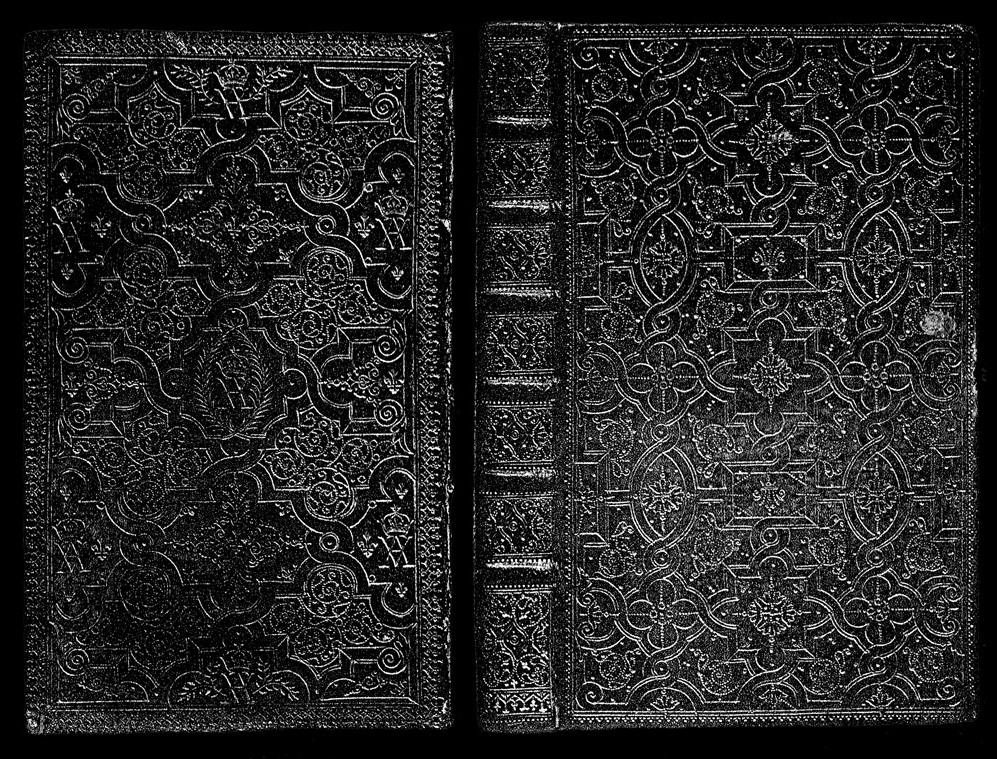


|
The binding reproduced above, of which we see the spine and board as well as the inner doublure, is from a 1884 Paris publication entitled: LA RELIURE ANCIENNE ET MODERNE - RECUEIL DE 116 PLANCHES with an introduction by Gustave Brunet. A collection of 116 photo engravings of the finest examples of French bookbinding produced from the 16th to 19th centuries. Compiled by one of France's most renowned bibliophiles, the reproductions portray works executed with lavish attention to detail by master bookbinders such as Padeloup, Clovis and Nicolas Eve, le Gascon, and Nicolas Derome. In addition, these works of art belonged to notables such as Jean Grolier, Francois Ier, Diane de Poitiers, Louis XIII, Mazarin, and Cosimo de Medicis, to name a few, and so their value rendered them inaccessible to the scrutiny of most bibliophiles. Therefore, through the precisely reproduced plates in this album, Brunet intended to give bibliophiles the opportunity to acquire a deeper knowledge of the details and artistry of the original bindings and also to appreciate the progress of the art through the centuries. In red, brown, or black and white, the plates are from the Bibliophile français (1808 - 1873). Keyed to the plates is a descriptive table, of which thirty-one more important and distinctive works receive enhanced descriptions. Foreword, introduction and table handsomely printed with wide margins. I have also reproduced above, a copy of the description of Plate 61 (Planche 61). This binding decorated with the Royal arms of Anne of Austria has been attributed by Brunet to Le Gascon. Esmerian does not mention this binding and unfortunately Brunet does not give any details about the book on which this binding is found. However a close study of the decorative gold tooling will reveal that this binding is not the work of Le Gascon, but derives rather from the Royal workshop of Macé and Antoine Ruette. On the previous page I reproduced a 1642 binding from the from the Bridwell Library, a close examination of the imprints found on this binding reveals that some of the decorative tools are identical to those found on bindings attributed by Esmerian to Macé and Antoine Ruette. I include here this binding for a second time to show its close relationship to the Plate 61 binding. |
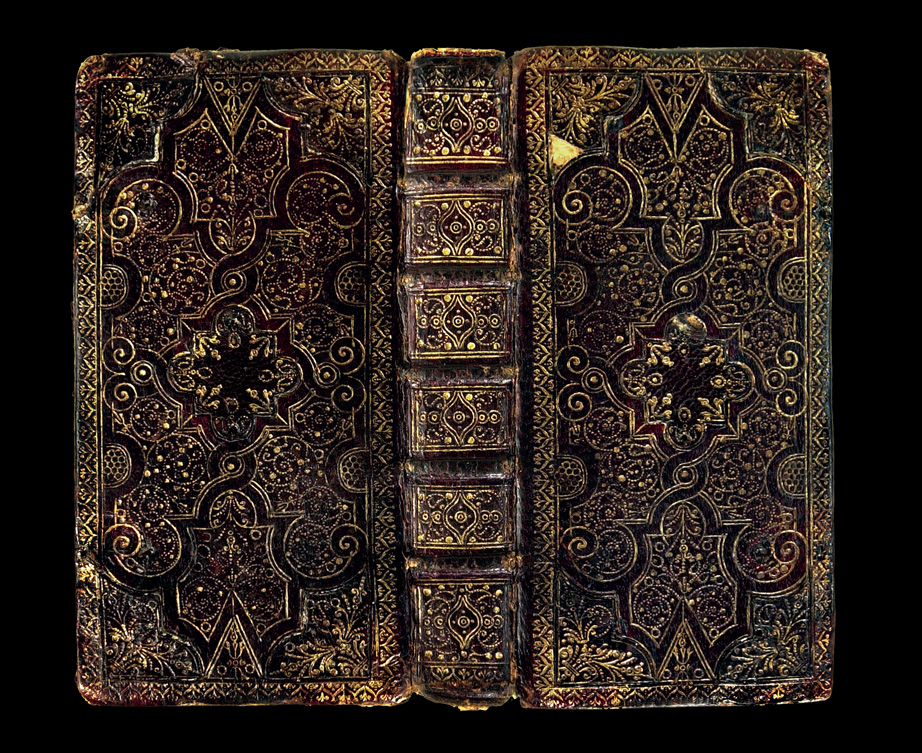
| Unfortunately Brunet's reproduction is a bit dark and one does not immediately notice an important detail that links these two bindings. When books are lined up on shelves the only distinctive 'mark' is that of the spine panel decoration. Often a particular binder can be identified by his favorite spine panel fleuron |
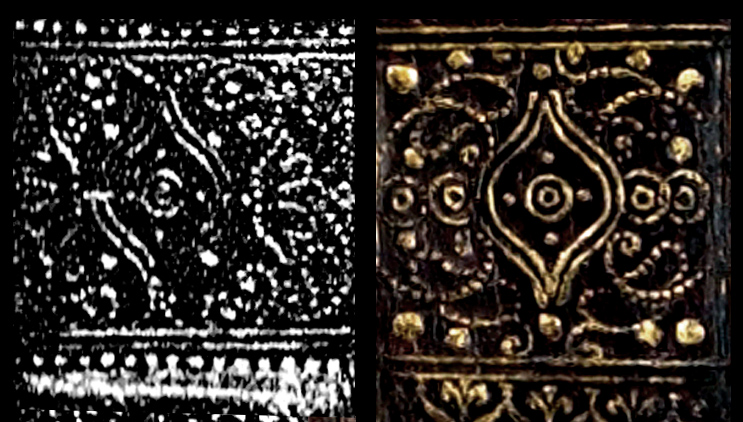
| Notice the unusual, almost simplistic central fleuron design flanked with small spirals, after enlarging a number of these small imprints I have reproduced below some examples that compare well. |
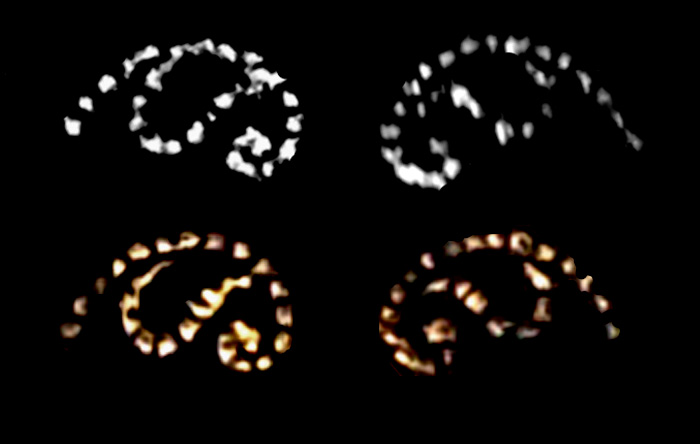
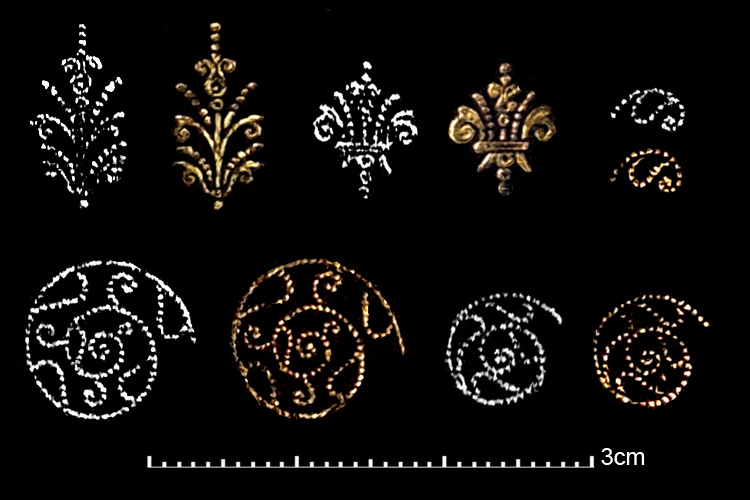
| In Comparative Diagram 3, we see that these imprints correspond closely, the exactness of the match is limited only by the quality of the reproduction and a difference in lighting, orientation etc, etc. We know from the previous page that the large spirals are identical to the Ruette mr-8 spirals , below I have reproduced copies of scroll wings from a 1633 Macé Ruette binding reproduced by Isabelle de Conihout & Pascal Ract-Madoux, Reliures françaises du XVIIe siècle , Paris 2002, page 26, example #8 |
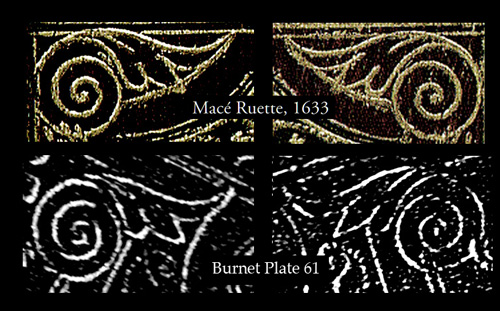
| I would like to present two more comparative diagrams before moving on to the next page where we will look at an exceptional reproduction of a 1644 Ruette binding, Below I compare a section from a Roll (roulette) from this 1644 binding with a similar section from Plate 61 |

| In conclusion we see that there are many Ruette tools found on Burnet's Plate 61 binding as well as on the Bridwell Library example. The roulette examples shown in Comparative Diagram 5, leave little doubt that these bindings share common tools however this roulette was not catalogued by Esmerian, although he does illustrate an a very similar example in his table of Macé Ruette tools. The value of these bindings, in terms of a comparative study is therefore very great. We can add these newly discovered tool imprints to our Ruette collection. Whether they were originally Macé Ruette tools that Antoine Ruette continued to use or tools that arrived in Antoine's workshop after the death of his father remains yet another sticky issue which I am going to touch on in the next page. |
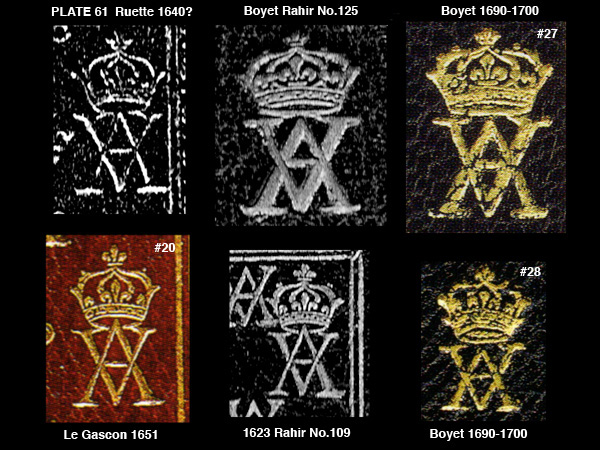
| As I final note of interest I would like to point out the Anne of Austria monogram found on the Plate 61 binding. I have reproduced it above as the first of six examples. This important "chiffre" becomes even more important due to a remarkable circumstance that has befuddled the most renowned experts, even Thoinan and Rahir were fooled by a series of retrospective bindings that are today attributed to Boyet. In the 2002 Paris publication of Isabelle de Conihout & Pascal Ract-Madoux, entitled Reliures françaises du XVIIe siècle : Chefs-d'oeuvre du musée Condé, we are told of a list of 106 books that were said to have belonged to Anne of Austria, (from Earnest Quentin Bauchart's book entitled Femmes bibliophiles). Of the one hundred and six books, thirty two are said to have been in bindings stamped with the chiffres of Anne of Austria. However according to the authors only one of these bindings is actually from the period of Louis XIII. This binding, they say, or one like it, served as a model for all the others. It is a small format (123 x 83 mm) in red morrocan , executed by Macé around 1635. (it now resides in the Bibliothèque National de France in the Lesouef collection). Unfortunately the authors do not reproduce this binding, and we can only surmise that the chiffre was faithfully copied. It is fortunate then that here in Plate 61 we find another, possibly similar (or identical?) example. The first important point of difference found in the examples shown in Comparative Diagram 6, is the fact that the top of the letter A, penetrates into the crown in the Ruette example while the Boyet examples all show the letter A as terminationg below the crown. Perhaps more obvious as a distinguishing feature is the fact that front leg of the "A" crosses over, (is in front of) the reversed A and the opposite leg of the reversed A pass over (is in front of) the other leg, the letters appear therefore, intertwined. The Boyet examples are just the opposite. This I think is a major difference that may even be a deliberate deviation from the original. Isabelle de Conihout & Pascal Ract-Madoux, show a number of examples of these retrospective bindings, I have extracted imprints from their #27 and #28 bindings. They also reproduce a binding which they atribute to Le Gascon (not Le Maitre Doreur) this is #8 and I have extracted from this, an imprint that looks very close to the Ruette plate 61 example, also they mention a Rahir 1910 reproduction (No. 109) in relation to their binding #2, both of these bindings seem to be by the same binder and may date to 1623, in which case they may actually be the work of Covis Eve? |
|
See the next page Antoine Ruette - Tool identification. Return to the previous page. Charenton bindings by Antoine Ruette. |
| Go to Digital Alchemy | Click on this link to visit cyclopaedia.org |